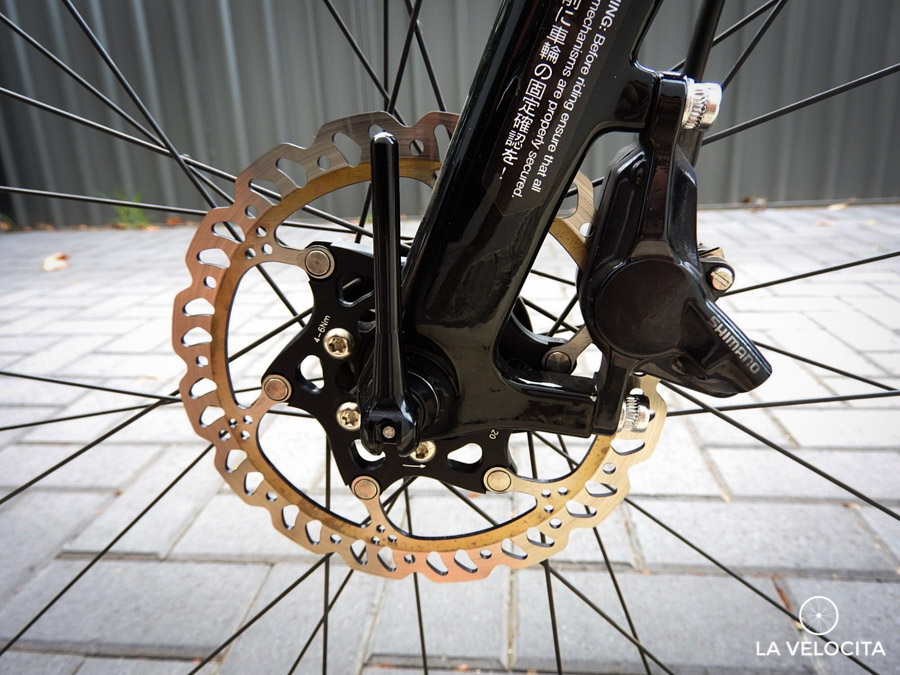Disc brakes – stopping too soon?

Just a few months after the introduction of disc brakes into professional road cycling, they’ve been deemed too unsafe for the peloton. Tom McQuillan examines the pros and cons of disc braking for road bikes.
Words - Tom McQuillan Images - Andrew Clifforth and James Raison
This month’s Paris-Roubaix was a momentous day – Tom Boonen nearly won what would have been a record-breaking fifth edition of the ‘Hell of the North’, Peter Sagan made a truly remarkable save in avoiding a crashing Fabian Cancellara, and Australia’s Mat Hayman came from the clouds to win the most exciting Paris-Roubaix in a decade. However, the date will now have further significance in the history of road cycling – it marks the end of road cycling’s first experimentation with disc brakes.
In case you haven’t seen it yet, the reason for disc brakes being banned from the pro peloton was a horrific looking knee injury åsuffered by Movistar’s Francisco Ventoso (you can see it here, but be warned – it’s not for the squeamish) around 130km into the race.
THE PROBLEMS WITH DISC BRAKES
After being stitched up by doctors, Ventoso wrote an open letter on Facebook blasting the dangers of disc brakes, suggesting that although disc brakes have their uses for cyclocross riders and recreational cyclists, “what will happen when 396 discs get into a race where 198 riders ferociously battle for position?”
Ventoso also made the point that “I haven’t met any rider who has run out of power with traditional [rim] brakes” and that he was very fortunate that the injuries suffered weren’t to more vulnerable parts of his body, posing the question “…can you imagine that disc cutting a jugular or a femoral vein?”
Ventoso’s concerns over the safety of disc brakes were followed by the riders’ union Cyclistes Professionels Associes (CPA), who had previously expressed doubts over the necessity of disc brakes in pro racing. They certainly haven’t been widely adopted by professional teams – only Lampre-Merida and Team Direct Energie used disc brakes in Paris-Roubaix, which is arguably the race where disc brakes offer the greatest potential advantages.
So if safety and an apparent lack of need for extra braking power are the reasons not to use disc brakes, what are the benefits?
THE BENEFITS OF DISC BRAKES
For starters, you don't need to clear water, mud or dust off your rim before the brake pads start to bite - meaning that disc brakes are much better suited to adverse conditions than rim brakes.
Another advantage for disc brake users is that with the brakes taken off the rims, there's no danger of riders melting the brake tracks of carbon fibre rims on long or steep descents. This minimises the risk of one (admittedly rare) type of crash, and also allows for more advanced and aerodynamic designs of wheels and rims.
Perhaps the most important factor of disc brakes for recreational riders is that they can offer increased bang for your buck when it comes to braking performance – hydraulic disc brakes (which have long been acknowledged by mountain bikers as being the most effective brakes for off-road use) are now available on mid-range road and cyclocross bikes, and with Shimano set to launch a new set of hydraulic disc brakes for its fourth-tier Tiagra groupset in the coming months, they’re more affordable than ever.
While this is great for the weekend warrior looking to improve their riding experience without breaking the bank, it’s less of an issue for pro cycling teams who are willing to pay for the best performing gear regardless of cost.
A POINT OF DIFFERENCE?
While the CPA and cycling’s governing body the Union Cycliste International (UCI) have both deemed disc brakes too unsafe for the moment, it must be said that there doesn’t seem to be a great level of demand for disc brakes among the pro peloton – the vast majority of pro riders are still using rim brakes, despite almost all having access to disc brakes. As Ventoso mentioned, pro riders are rarely wanting for more efficient braking, and several riders have raised concerns about having different levels of stopping power in riders brakes, which may cause pileups when riders try to avoid fallen comrades. Additionally, the differing sizes of disc brake rotors available make changing wheels in the event of a mechanical mishap more troublesome.
But while the riders and the UCI are opposed to keeping disc brakes in the peloton, the recreational side of the sport has been making leaps and bounds towards disc brakes.
When it comes to road bikes, Giant - the biggest-selling brand in all of cycling - is now selling the its extremely popular Defy with disc brakes in all but the cheapest spec, while its American counterpart Specialized offer disc brake versions of its two highest selling road bikes, the Tarmac and Roubaix.
Even more remarkable in the year or two has been the explosion in bikes known variously as gravel grinders, all-terrain road bikes and adventure bikes. It’s in this category of road bikes with off-road capabilities (where there’s no overlap with the pro cycling market) that disc brakes have become ubiquitous on bikes like the Specialized Diverge, the Cannondale Slate, the Giant AnyRoad and the GT Grade.
Bikes in this category have been selling like hotcakes, so between this category and increasing demand for road bikes equipped with disc brakes, it seems like disc brakes will still remain a part of the road cycling landscape whether or not we see them being used by Tour de France winners or cobbled classics stars.
What do you think? What does the future hold for disc brakes in road biking, both in and out of the professional peloton?
What more good stuff from La Velocita? Well subscribe by dropping your e-mail into the the box below and hitting subscribe. You'll be happier as a result and we'll all feel warm and fuzzy.








